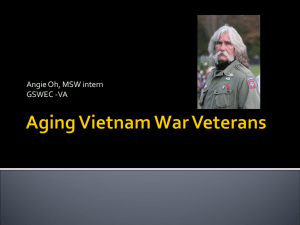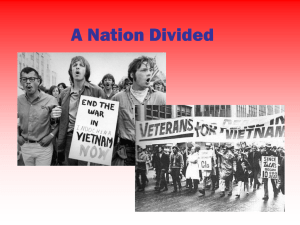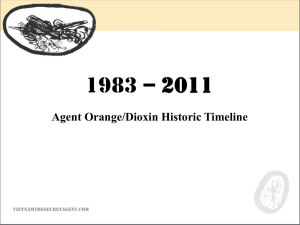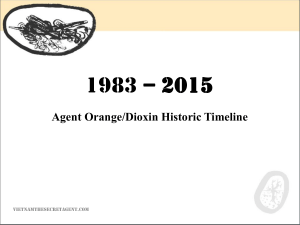AGENT ORANGE
advertisement
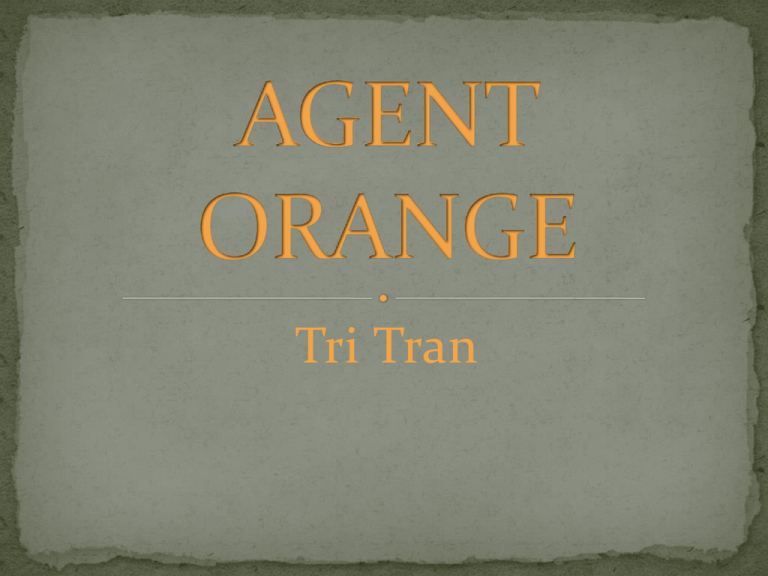
Tri Tran INTRODUCTION CHEMICAL DESCRIBTION TOXICOLOGY Used Effect Reference WRITTEN ASSIGMENT AGENT ORANGE IS An HERBICIDE AND DEFOLIANT USED BY U.S. MILITARY 1961-1971 in Vietnam war MIXTURE 1:1 OF TWO HERBICIDES 2,4,5-T AND 2,4D Manufactured for the U.S. Department of Defense primarily by MOSANTO CORPORATION and DOW CHEMICAL The 2,4,5-T used to produce Agent Orange was contaminated with 2,3,7,8-tetrachlorodibenzodioxin (TCDD) , an extremely toxic dioxin compound 1:1 MIXTURE OF TWO PHENOXYL HERBICIDES 2,4-Dichlorophenoxyacetic acid(2,4-D) 2,4,5-Trichlorophenoxyacetic acid (also known as 2,4,5-T) 2,4,5-T was contaminated with a dioxin, 2,3,7,8- Tetrachlorodibenzodioxin (TCDD) TCDD has been described as "perhaps the most toxic molecule ever synthesized by man". The National Toxicology Program has classified TCDD as "known to be a human CARCINORGEN” The half-life of dioxins in soil is more than 10 years, and TCDD in human fat tissue is about 7 years. the United States military sprayed nearly 20,000,000 U.S. gallons (75,700,000 l) the goal was to defoliate rural/forested land 12 percent of the total area of South Vietnam had been sprayed TCDD concentrations in soil and water were hundreds of times greater than the levels considered safe by the U.S. Environmental Protection Agency 4 million citizens were exposed, about 3 million have suffered illnesses Children in the areas have multiple health problems: including cleft palate, mental disabilities, hernias, and extra fingers and toes, High levels of dioxin were found in the breast milk of South Vietnamese women The contaminated soil and sediment poisoning food chain and causing illnesses, serious skin diseases and a variety of cancers in the lungs, larynx, and prostate the veterans were told not to worry, and were persuaded the chemical was harmless. high levels of dioxin in the blood of U.S. military rates of cancer, and nerve, digestive, skin, and respiratory disorders have increased. had higher rates of throat cancer, acute/chronic leukemia, Hodgkin's lymphoma and non-Hodgkin's lymphoma, prostate cancer, lung cancer, colon cancer, soft tissue sarcoma and liver cancer. Use Veterans began to file claims in 1977 to the Department of Veterans Affairs => claims were denied From 1978, several lawsuits have been filed against the companies which produced Agent Orange Vietnam Association for Victims of Agent Orange/dioxin (VAVA), filed a lawsuit judges dismissed the case http://www.science20.com/news_articles/agent_orange_linked_skin_cancer_risk-128602 Buckingham. "The Air Force and Herbicides“ Fawthrop, Tom; "Vietnam's war against Agent Orange", BBC News, June 14, 2004 Fawthrop, Tom; "Agent of Suffering", Guardian, February 10, 2008 Galston, Authur (Feb 1979). "Herbicides: A Mixed Blessing". Bioscience 29 (2): 85–90. doi:10.2307/1307744. JSTOR 1307744. Retrieved 2014-09-13. http://www.oocities.org/capecanaveral/Hall/1443/agento.html pellow-2007-159 Tucker, Spencer. Encyclopedia of the Vietnam War: Political, Social and Military History. ABC-CLIO, Inc. Santa Barbara. 1997. Agent Orange blights Vietnam". BBC News. December 3, 1998. Retrieved April 23, 2010. Hermann, Kenneth J.; "Killing Me Softly: How Agent Orange Murders Vietnam's Children", Political Affairs, April 25, 2006 February 22, 2008 Decision by the Second Circuit Court of Appeals re: Vietnam Association of Victims of Agent Orange v. Dow Chemical Co." . Retrieved 2012-07-07. "Order List" (PDF). The United States Supreme Court. March 2, 2009. p. 7. Archived from the original on 5 June 2010. Retrieved May 4, 2010 An informational pamphlet
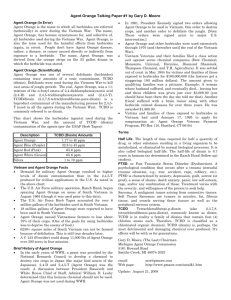

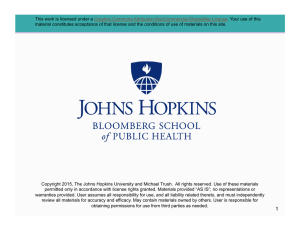
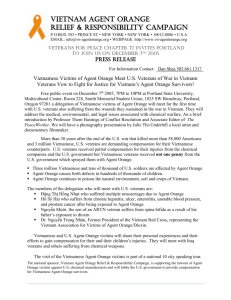

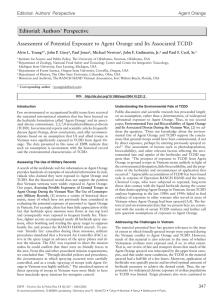
![vietnam[1].](http://s2.studylib.net/store/data/005329784_1-42b2e9fc4f7c73463c31fd4de82c4fa3-300x300.png)

